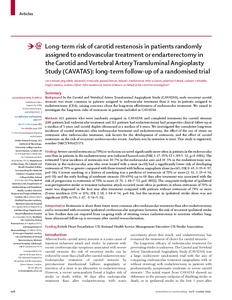Bonati, LH;
Ederle, J;
McCabe, DJ;
Dobson, J;
Featherstone, RL;
Gaines, PA;
Beard, JD;
Venables, GS;
Markus, HS;
Clifton, A;
et al.
Bonati, LH; Ederle, J; McCabe, DJ; Dobson, J; Featherstone, RL; Gaines, PA; Beard, JD; Venables, GS; Markus, HS; Clifton, A; Sandercock, P; Brown, MM; CAVATAS Investigators
(2009)
Long-term risk of carotid restenosis in patients randomly assigned to endovascular treatment or endarterectomy in the Carotid and Vertebral Artery Transluminal Angioplasty Study (CAVATAS): long-term follow-up of a randomised trial.
LANCET NEUROLOGY, 8 (10).
908 - 917.
ISSN 1474-4422
https://doi.org/10.1016/S1474-4422(09)70227-3
SGUL Authors: Markus, Hugh Stephen
![[img]](https://openaccess.sgul.ac.uk/463/1.hassmallThumbnailVersion/1-s2.0-S1474442209702273-main.pdf)  Preview |
|
["document_typename_application/pdf; charset=binary" not defined]
Published Version
Download (143kB)
| Preview
|
Abstract
Background
In the Carotid and Vertebral Artery Transluminal Angioplasty Study (CAVATAS), early recurrent carotid
stenosis was more common in patients assigned to endovascular treatment than it was in patients assigned to
endarterectomy (CEA), raising concerns about the long-term eff ectiveness of endovascular treatment. We aimed to
investigate the long-term risks of restenosis in patients included in CAVATAS.
Methods
413 patients who were randomly assigned in CAVATAS and completed treatment for carotid stenosis(200 patients had endovascular treatment and 213 patients had endarterectomy) had prospective clinical follow-up at a median of 5 years and carotid duplex ultrasound at a median of 4 years. We investigated the cumulative long-term incidence of carotid restenosis after endovascular treatment and endarterectomy, the effect of the use of stents on restenosis after endovascular treatment, risk factors for the development of restenosis, and the eff ect of carotid restenosis on the risk of recurrent cerebrovascular events. Analysis was by intention to treat. This study is registered, number ISRCTN01425573.
Findings
Severe carotid restenosis (≥70%) or occlusion occurred significantly more often in patients in the endovascular
arm than in patients in the endarterectomy arm (adjusted hazard ratio [HR] 3·17, 95% CI 1·89–5·32; p<0·0001). The
estimated 5-year incidence of restenosis was 30·7% in the endovascular arm and 10·5% in the endarterectomy arm.
Patients in the endovascular arm who were treated with a stent (n=50) had a signifi cantly lower risk of developing
restenosis of 70% or greater compared with those treated with balloon angioplasty alone (n=145; HR 0·43, 0·19–0·97;
p=0·04). Current smoking or a history of smoking was a predictor of restenosis of 70% or more (2·32, 1·19–4·54;
p=0·01) and the early fi nding of moderate stenosis (50–69%) up to 60 days after treatment was associated with the risk of progression to restenosis of 70% or more (3·76, 1·88–7·52; p=0·0002). The composite endpoint of ipsilateral
non-perioperative stroke or transient ischaemic attack occurred more often in patients in whom restenosis of 70% or
more was diagnosed in the fi rst year after treatment compared with patients without restenosis of 70% or more
(5-year incidence 23%vs 11%; HR 2·18, 1·04–4·54; p=0·04), but the increase in ipsilateral stroke alone was not
significant (10% vs 5%; 1·67, 0·54–5·11).
Interpretation
Restenosis is about three times more common after endovascular treatment than after endarterectomy and is associated with recurrent ipsilateral cerebrovascular symptoms; however, the risk of recurrent ipsilateral stroke
is low. Further data are required from on-going trials of stenting versus endarterectomy to ascertain whether long-
term ultrasound follow-up is necessary after carotid revascularisation
| Item Type: |
Article
|
| Additional Information: |
Copyright © 2009 Elsevier Ltd. Published version made available here with permission from the publisher. |
| Keywords: |
Science & Technology, Life Sciences & Biomedicine, Clinical Neurology, Neurosciences & Neurology, STENOSIS, PREDICTORS, PROTOCOL, SURGERY, Aged, Angioplasty, Balloon, Coronary, Carotid Stenosis, Coronary Restenosis, Endarterectomy, Carotid, Female, Follow-Up Studies, Humans, Incidence, Male, Risk Factors, Stents, Stroke, Treatment Outcome |
| Journal or Publication Title: |
LANCET NEUROLOGY |
| ISSN: |
1474-4422 |
| Related URLs: |
|
| Web of Science ID: |
WOS:000270111200013 |
| Dates: |
| Date |
Event |
| 2009-10-01 |
Published |
|
 |
Download EPMC Full text (HTML)
|
| URI: |
https://openaccess.sgul.ac.uk/id/eprint/463 |
| Publisher's version: |
https://doi.org/10.1016/S1474-4422(09)70227-3 |
Statistics
Item downloaded times since 30 Apr 2015.
Actions (login required)
 |
Edit Item |


